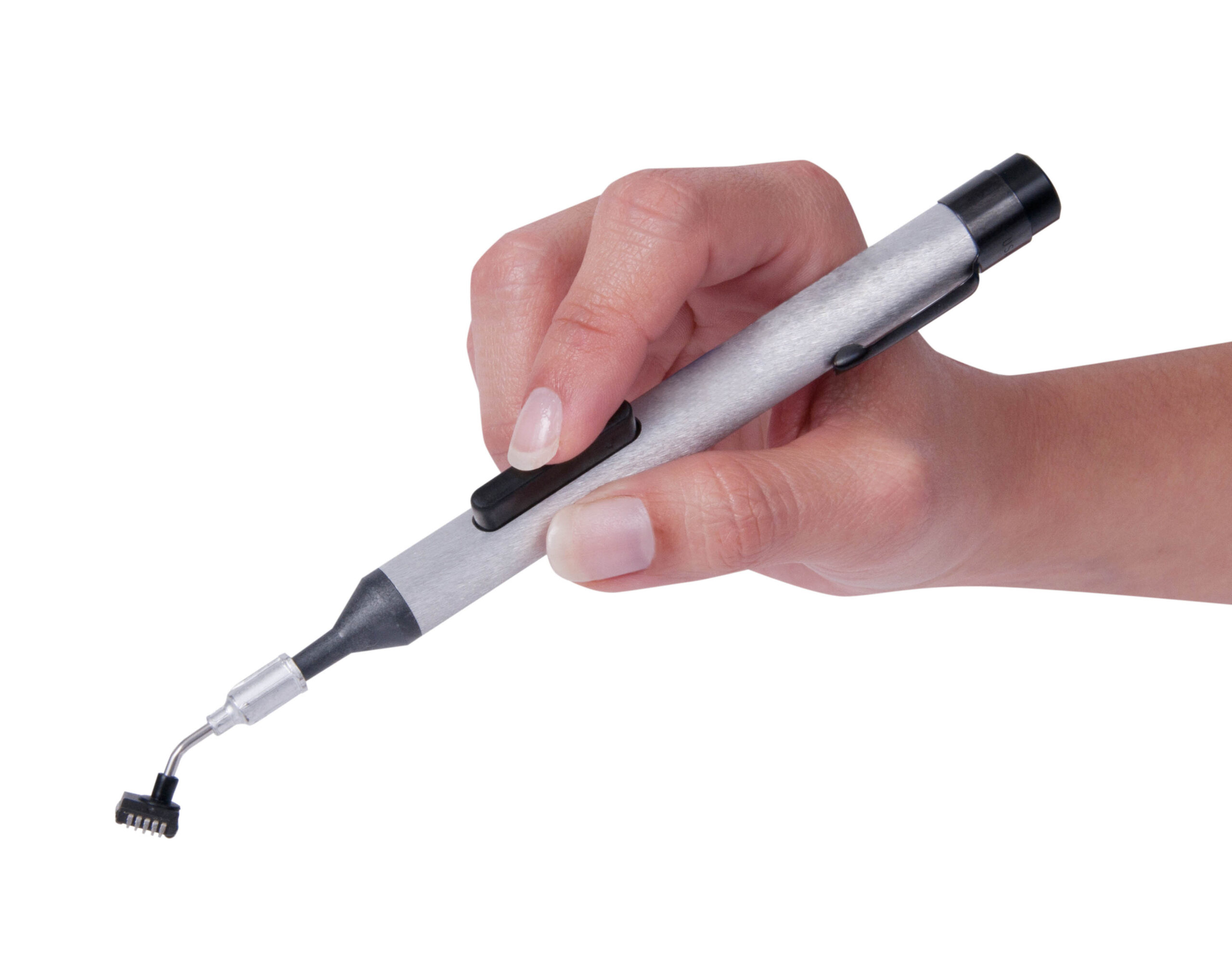A vacuum pen has pinpoint precision and easily changeable tips. It’s the universal tool to pick up and place IC components or other tiny parts easily and quickly while repairing. Easy handling and its small form make it the perfect tool for everyday use. In this blog, we’ll give you a full guide on different vacuum pens
How to use a vacuum pen?
- Install the suction header on the pen.
- Place the suction header level on the component you want to work on.
- Choose a probe with a vacuum cup that is slightly smaller in diameter than the outline of the parts that you want to pick and place.
- Gently install it on the tap end of the vacuum handle.
- Avoid choosing a vacuum cup that is too large or too small, cuz it will result in improper operation.
- Use vacuum pens with suction cups smaller than the size of the component, to make sure the components don’t get damaged,
- Place your index finger on the vacuum button and push in, hold this position and gently place the vacuum cup on top of the part that you wish to pick up.
- Now release the button, and the part would firmly latch onto the vacuum cup.
- Move the part to where you want to remove or replace it.
- Simply push the vacuum button in to release the part.
- The vacuum unit releases air to let the part fall off the suction header.
Why would you use a vacuum pen?
- It is a low-cost alternative to tweezers for picking and placing delicate parts
- Picks up metal, plastic, surface mount resistors, or any other item having a smooth – unporous surface that the rubber vacuum tip can seal against.
- Extra soft silicone suction cups won’t scratch or damage sensitive parts.
- The electrostatic energy inducing from your body will destroy the IC you’re soldering. So you’ll need the ESD-safe vacuum cups, which will help you dump the static to the ground.
- A vacuum cup can tolerate immediate high temperatures.
Types of vacuum pens:
1. Vampire vacuum pen
The vampire vacuum pen is a handheld, battery-free vacuum pick-up pen. It is designed for the safe pick-up of SMD components during assembly, test, and rework processes. Vampire grabs, lifts, and places components with complete safety, supported by a powerful internal piston.
Features:
- ESD Safe.
- General purpose component handling.
- Two different tips
- Three different cup sizes.
- Fountain-pen dimensions.
- Vampire body,
- 1 conductive metal straight needle
- 1 45° angled metal needle,
- 1 conductive rubber cup 4 mm
- 1 conductive rubber cup 6mm
- 1 conductive rubber cup 9 mm,
- 1 lubricant kit.
2. New black ESD safe vacuum pen
Anti-Static vacuum pen, well known as an IC component picker. It is a compact and portable pick-up tool, which can move chips, crystal wafers, and components on the motherboard safely and efficiently. Vacuum suction is operated by pressing and releasing the trigger
3. Handi-Vac Vacuum Pen
HANDI-VAC is a low-cost and easy-to-pick-and-place tool that can go into everybody’s toolbox.
Features:
- ESD Safe.
- General purpose component handling.
- Four different tips.
- 1 bent and 1straight probe with 1/8” (3.18mm) diameter vacuum cups.
- 1 bent probe with a ¼” (6.35mm) diameter vacuum cup
- 1 straight probe with 3/8” (9.53mm).
4. VacuPik Pen
This vacuum pen body includes a pocket clip and a convenient storage space for extra cups & probes. Cups can be mounted onto probes or directly onto the tool itself. ESD safe tool handle to tip resistance is 108-1011 Ohms.
Features:
- ESD Safe Portable Vacuum Pen
- Static Dissipative Plastic Nozzle
- Dimensions – Length = 5.75″ (146mm) / Diameter = .50″ (1.27mm)
- Weight = .060 oz.
Conclusion:
A vacuum pen is a very handy device that prevents any damage to your components. Make sure that the parts to be handled must be flat and dry.
Also, read USB Express Driver and How to Use it.

